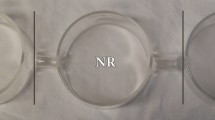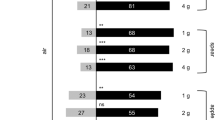Abstract
The jumping spider Evarcha culicivora (Salticidae) has unusual links to Lantana camara, a plant species to which it is attracted. Three phytochemicals from the headspace of L. camara (1,8 cineole and especially β-caryophyllene and α-humulene) attract adult E. culicivora. These spiders, especially early-instar juveniles, feed on nectar, but adults may use L. camara as mating sites. The hypothesis we consider here is that, for E. culicivora juveniles, although not for adults, responding to plant odor is relevant in the specific context of acquiring nectar meals. We show that juveniles resemble adults by responding to β-caryophyllene and α-humulene, but we found no significant attraction of juveniles to 1,8 cineole. We also show that, compared to sated E. culicivora juveniles, juveniles subjected to a 5-day pre-trial fast responded more strongly to living L. camara plants and to β-caryophyllene and α-humulene, but we found no significant effect of hunger level on response by adults to living plants. These results suggest that attraction to L. camara may have different functions for E. culicivora depending on the stage of its life history.

Similar content being viewed by others
References
Andersson S, Nilsson LA, Groth I, Bergstrom G (2002) Floral scents in butterfly-pollinated plants: possible convergence in chemical composition. Bot J Linn Soc 140:129–153
Bruce TJA, Wadhams LJ, Woodcock CM (2005) Insect host location: a volatile situation. Trends Plant Sci 10:269–274
Chen Y, Chen L, Wu Y, Chen PJ, Liu F (2010) A survey of nectar feeding in three different habitats. Bull Insectol 63:203–208
Cross FR, Jackson RR (2009) Odour-mediated response to plants by Evarcha culicivora, a blood-feeding jumping spider from East Africa. N Z J Zool 36:75–80
Dumpert K (1978) Spider odor receptors: electrophysiological proof. Cell Mol Life Sci 34:754–756
Foelix RF, Chu-Wang I-W (1973) The morphology of spidersensilla II. Chemoreceptors. Tissue Cell 5:461–478
Jackson RR, Pollard SD, Nelson XJ, Edwards GB, Barrion AT (2001) Jumping spiders (Araneae: Salticidae) that feed on nectar. J Zool 255:25–29
Jackson RR, Nelson XJ, Sune GO (2005) A spider that feeds indirectly on vertebrate blood by choosing female mosquitoes as prey. Proc Natl Acad Sci USA 102:15155–15160
Kessler A, Morrell K (2010) Plant volatile signalling: multitrophic interactions in the headspace. In: Herrmann A (ed) The chemistry and biology of volatiles. Wiley, Chichester, pp 95–122
Kuja JO, Sune GO, Karanja RNH, Lagat ZO, Jackson RR, Carvell GE (2012) Nectar meals of a mosquito-specialist spider. Psyche. Article ID 898721. doi:10.1155/2012/898721
Morse DH (2007) Predator upon a flower: life history and fitness in a crab spider. Harvard University Press, Cambridge
Nahas L, Gonzaga MO, Del-Claro K (2012) Emergent impacts of ant and spider interactions: herbivory reduction in a tropical savanna tree. Biotropica 44:498–505
Nelson XJ, Jackson RR (2012) Fine tuning of vision-based prey-choice decisions by a predator that targets malaria vectors. J Arachnol 40:23–33
Nelson XJ, Pratt AJ, Cheseto X, Torto B, Jackson RR (2012) Mediation of a plant–spider association by specific volatile compounds. J Chem Ecol 38:1081–1092
Pollard SD, Beck MW, Dodson GN (1995) Why do male crab spiders drink nectar? Anim Behav 49:1443–1448
Romero GQ, Souza JS, Vasconcellos-Neto J (2008) Anti-herbivore protection by mutualistic spiders and the role of plant glandular trichomes. Ecology 89:3105–3115
Taylor RM, Pfannenstiel RS (2008) Nectar feeding by wandering spiders on cotton plants. Env Entomol 37:996–1002
Vallet AM, Marion-Poll F, Trabalon M (1998) Preliminary electrophysiological study of the contact chemoreceptors in a spider. C R Acad Sci 321:463–469
Acknowledgments
We thank Stephen Abok Aluoch and Jane Atieno Obonyo for their assistance at ICIPE. Our research was supported in part by the National Geographic Society (Grant 8676-09) and by National Institutes of Health (NIH) grants R21-AI062957 and R01-AI077722 from the National Institute of Allergy and Infectious Diseases (NIAID).
Author information
Authors and Affiliations
Corresponding author
Rights and permissions
About this article
Cite this article
Nelson, X.J., Jackson, R.R. Hunger-driven response by a nectar-eating jumping spider to specific phytochemicals. Chemoecology 23, 149–153 (2013). https://doi.org/10.1007/s00049-013-0130-5
Received:
Accepted:
Published:
Issue Date:
DOI: https://doi.org/10.1007/s00049-013-0130-5




